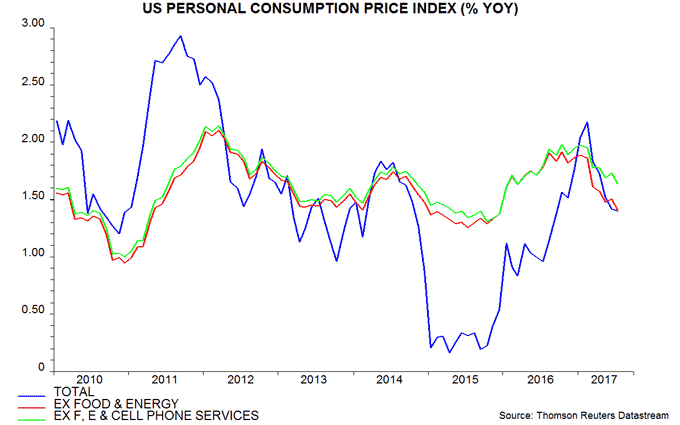Cell phone effect cuts US inflation, boosts growth
A significant portion of the recent fall in US core inflation is attributable to a quality adjustment to cellular phone charges to reflect plans allowing unlimited data usage. This statistical effect should – and probably will – be ignored by the Fed in deciding how fast to “normalise” monetary policy.
The Fed’s preferred core inflation measure – the annual increase in the personal consumption expenditure price index excluding food and energy – fell further to 1.41% in July compared with a recent peak of 1.91% in October 2016. Three-tenths of the reduction over this period is attributable to a much faster rate of decline of cell phone charges. A modified core measure excluding cell phone services fell from 1.98% to 1.63% between October and July – see chart.

Cell phone users aren’t spending any less: aggregate outlays on cell phone services actually grew by 1.1% in the year to July. Official statisticians, however, reckon that consumers are getting much better value for money, mainly reflecting the shift to unlimited data plans, so their estimate of the price per unit of services has fallen by 13.3% over the past 12 months.
By extension, the volume of services consumed, according to the statisticians, has surged by 16.5% over the past year, contributing 0.21 percentage points to overall personal consumption growth of 2.72%.
This statistical procedure may or may not be justified but the negative impact on inflation should be ignored by the Fed, because the shift to unlimited data plans is a unique event and has no relevance for assessing whether monetary conditions are appropriate to achieve the 2% inflation target over the medium term.
Core inflation excluding cell phone services of 1.63% in July is below a 2016 average of 1.80% but up from 1.39% in 2015. The Fed must balance the current undershoot against a rising pressure of demand on available supply capacity, suggesting a future inflation increase. Economic strength in late 2017 / early 2018 is expected here to shift the Fed’s concern towards the latter, even if core inflation remains at its current level.

Reader Comments